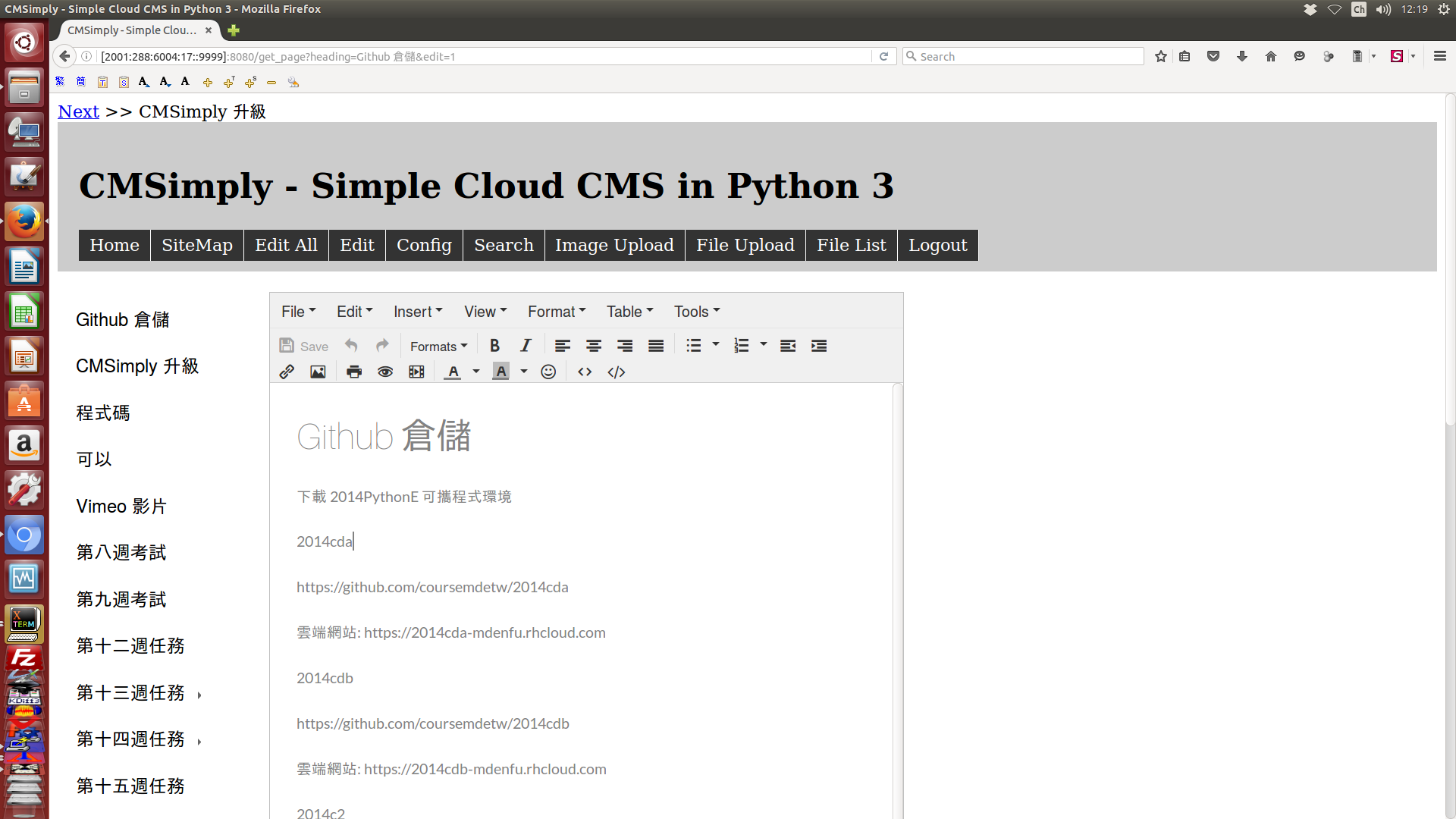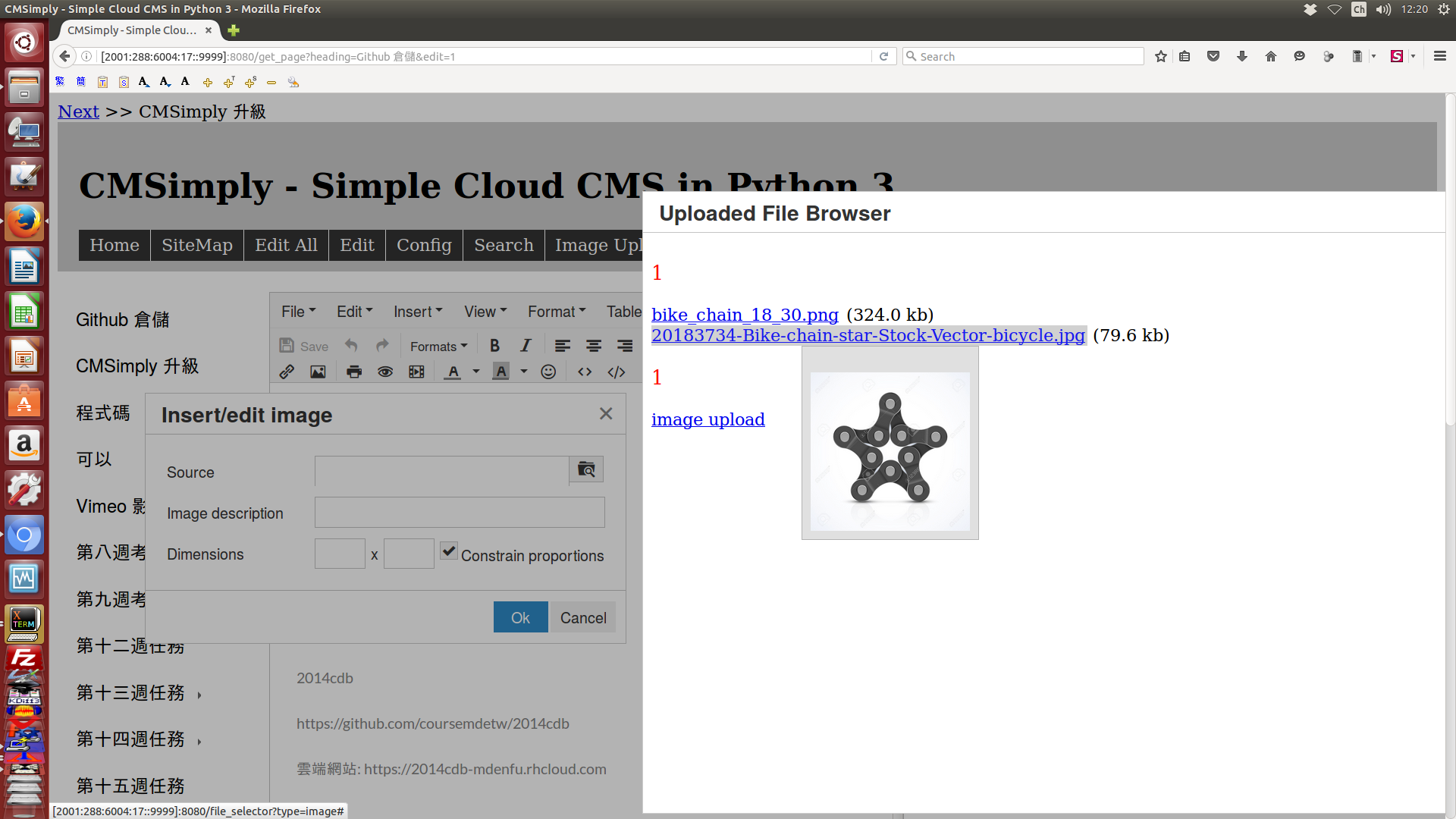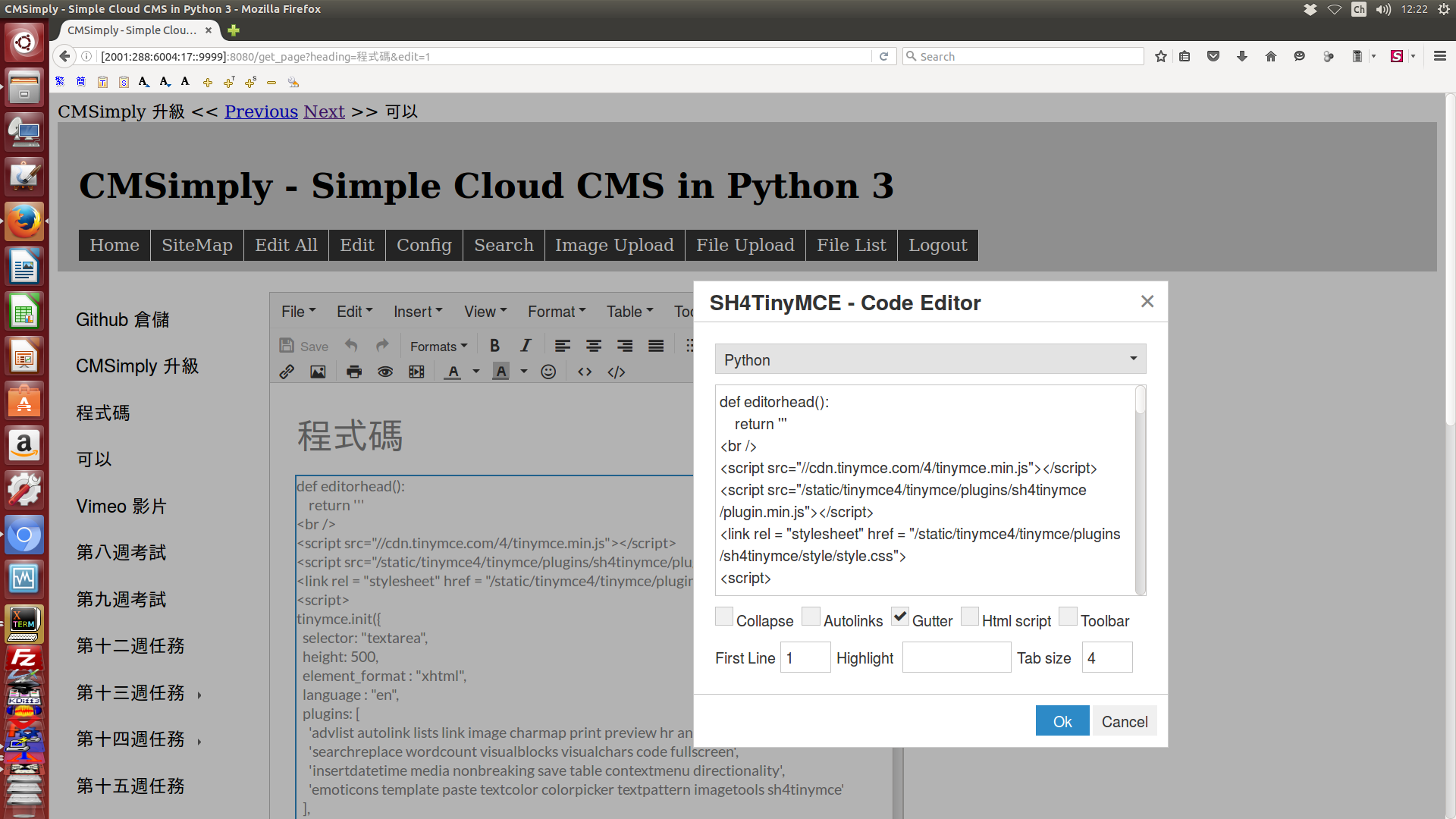IPV6 是工業 4.0 的一項重要技術, 隨著電腦輔助設計室導入 IPV6, 作為網際程式教學用的 CMSimply 也必須配合轉到 IPV6 相容的環境.
有關機械設計工程系 IPV6 位址規劃, 請參考 http://cadlab.mde.tw/post/ji-jie-she-ji-gong-cheng-xi-ipv6-wang-zhi-fen-pei.html.
至於測試純 IPV6 環境, 假如是在 Host 主機內部, 可以啟用 Host-only 的網路設定, 以內部 fd00::/8 網址進行測試. 假如是要建立外部 IPV6 測試主機, 則可使用 Bridged 網路卡, 直接在廣域網路上執行測試, 相關設定細節請參考 http://cadlab.mde.tw/post/kua-cao-zuo-xi-tong-de-virtualbox-vdi-dang-an.html.
CMSimply 的原始碼位於: https://github.com/chiamingyen/cmsimply.git.
本次版本的修改, 主要問題在原先的 tinymce3 無法正確解析 IPV6 網址, 有些團隊著重在修改 tinymce3, 讓舊程式碼可以在 IPV6 環境中使用, 但是 https://www.tinymce.com/ 第 4 版的程式碼較第 3 版精簡許多 ,設定也比較多元, 因此 CADLab 決定直接將 CMSimply 的 html5 編輯器升級到 tinymce4.
升級修改的部份主要集中在 3 個項目, 也就是(1)設定差異, (2)檔案引用差異, (3)程式碼 highlight 引用差異等, 首先就是 tinymce3 與 tinymce4 的啟用設定不同, 許多舊的方法都已經作廢, 因此將程式碼引用導向開放源版本的 tinymce4 之後, 就必須配合修改設定, 與 CMSimply 有關的主要設定檔為全域方法中的 editorhead:
def editorhead():
return '''
<br />
<script src="//cdn.tinymce.com/4/tinymce.min.js"></script>
<script src="/static/tinymce4/tinymce/plugins/sh4tinymce/plugin.min.js"></script>
<link rel = "stylesheet" href = "/static/tinymce4/tinymce/plugins/sh4tinymce/style/style.css">
<script>
tinymce.init({
selector: "textarea",
height: 500,
element_format : "xhtml",
language : "en",
plugins: [
'advlist autolink lists link image charmap print preview hr anchor pagebreak',
'searchreplace wordcount visualblocks visualchars code fullscreen',
'insertdatetime media nonbreaking save table contextmenu directionality',
'emoticons template paste textcolor colorpicker textpattern imagetools sh4tinymce'
],
toolbar1: 'insertfile save undo redo | styleselect | bold italic | alignleft aligncenter alignright alignjustify | bullist numlist outdent indent',
toolbar2: 'link image | print preview media | forecolor backcolor emoticons | code sh4tinymce',
relative_urls: false,
toolbar_items_size: 'small',
file_picker_callback: function(callback, value, meta) {
cmsFilePicker(callback, value, meta);
},
templates: [
{ title: 'Test template 1', content: 'Test 1' },
{ title: 'Test template 2', content: 'Test 2' }
],
content_css: [
'//fonts.googleapis.com/css?family=Lato:300,300i,400,400i',
'//www.tinymce.com/css/codepen.min.css'
]
});
function cmsFilePicker(callback, value, meta) {
tinymce.activeEditor.windowManager.open({
title: 'Uploaded File Browser',
url: '/file_selector?type=' + meta.filetype,
width: 800,
height: 550,
}, {
oninsert: function (url, objVals) {
callback(url, objVals);
}
});
};
</script>
'''
其中最重要的設定為 relative_urls: false, 主要是讓 tinymce4 針對編輯內容中的網址引用, 採用絕對網址, 而不要讓 tinymce4 將 IPV6 網址修改為相對網址, 因為轉換過程會截斷 IPV6 網址而出錯.
第 2 項重要的設定則是:
file_picker_callback: function(callback, value, meta) {
cmsFilePicker(callback, value, meta);
}
也就是所謂 file_picker_callback 函式的宣告, 這裡使用 anonymous 函式格式, 將檔案選擇的回呼函式設為 cmsFilePicker, 也就是隨後編寫的:
function cmsFilePicker(callback, value, meta) {
tinymce.activeEditor.windowManager.open({
title: 'Uploaded File Browser',
url: '/file_selector?type=' + meta.filetype,
width: 800,
height: 550,
}, {
oninsert: function (url, objVals) {
callback(url, objVals);
}
});
其中的關鍵是要求使用者按下檔案引用選擇按鈕時, 會經由 url 所指定的 '/file_selector?type=' + meta.filetype' 執行, 而這個 file_selector 方法內容為:
@cherrypy.expose
def file_selector(self, type=None, page=1, item_per_page=10, keyword=None):
if not self.isAdmin():
raise cherrypy.HTTPRedirect("login")
else:
if type == "file":
type = 'downloads'
return file_lister("downloads", type, page, item_per_page)
elif type == "image":
#return images_file_selector()
return file_lister("images", type, page, item_per_page)
可以根據 type 決定引用上傳的 file 或 image, 分別導向不同的伺服器目錄, 列出可以引用的檔案.
而且因為 file_lister 方法中的所有可選檔案, 都以 anchor 製作, 內容如下:
def file_lister(directory, type=None, page=1, item_per_page=10):
files = os.listdir(download_root_dir+directory)
total_rows = len(files)
totalpage = math.ceil(total_rows/int(item_per_page))
starti = int(item_per_page) * (int(page) - 1) + 1
endi = starti + int(item_per_page) - 1
outstring = file_selector_script()
notlast = False
if total_rows > 0:
outstring += "<br />"
if (int(page) * int(item_per_page)) < total_rows:
notlast = True
if int(page) > 1:
outstring += "<a href='"
outstring += "file_selector?type="+type+"&page=1&item_per_page="+str(item_per_page)+"&keyword="+str(cherrypy.session.get('download_keyword'))
outstring += "'><<</a> "
page_num = int(page) - 1
outstring += "<a href='"
outstring += "file_selector?type="+type+"&page="+str(page_num)+"&item_per_page="+str(item_per_page)+"&keyword="+str(cherrypy.session.get('download_keyword'))
outstring += "'>Previous</a> "
span = 10
for index in range(int(page)-span, int(page)+span):
#for ($j=$page-$range;$j<$page+$range;$j++)
if index>= 0 and index< totalpage:
page_now = index + 1
if page_now == int(page):
outstring += "<font size='+1' color='red'>"+str(page)+" </font>"
else:
outstring += "<a href='"
outstring += "file_selector?type="+type+"&page="+str(page_now)+"&item_per_page="+str(item_per_page)+"&keyword="+str(cherrypy.session.get('download_keyword'))
outstring += "'>"+str(page_now)+"</a> "
if notlast == True:
nextpage = int(page) + 1
outstring += " <a href='"
outstring += "file_selector?type="+type+"&page="+str(nextpage)+"&item_per_page="+str(item_per_page)+"&keyword="+str(cherrypy.session.get('download_keyword'))
outstring += "'>Next</a>"
outstring += " <a href='"
outstring += "file_selector?type="+type+"&page="+str(totalpage)+"&item_per_page="+str(item_per_page)+"&keyword="+str(cherrypy.session.get('download_keyword'))
outstring += "'>>></a><br /><br />"
if (int(page) * int(item_per_page)) < total_rows:
notlast = True
if type == "downloads":
outstring += downloadselect_access_list(files, starti, endi)+"<br />"
else:
outstring += imageselect_access_list(files, starti, endi)+"<br />"
else:
outstring += "<br /><br />"
if type == "downloads":
outstring += downloadselect_access_list(files, starti, total_rows)+"<br />"
else:
outstring += imageselect_access_list(files, starti, total_rows)+"<br />"
if int(page) > 1:
outstring += "<a href='"
outstring += "file_selector?type="+type+"&page=1&item_per_page="+str(item_per_page)+"&keyword="+str(cherrypy.session.get('download_keyword'))
outstring += "'><<</a> "
page_num = int(page) - 1
outstring += "<a href='"
outstring += "file_selector?type="+type+"&page="+str(page_num)+"&item_per_page="+str(item_per_page)+"&keyword="+str(cherrypy.session.get('download_keyword'))
outstring += "'>Previous</a> "
span = 10
for index in range(int(page)-span, int(page)+span):
#for ($j=$page-$range;$j<$page+$range;$j++)
if index >=0 and index < totalpage:
page_now = index + 1
if page_now == int(page):
outstring += "<font size='+1' color='red'>"+str(page)+" </font>"
else:
outstring += "<a href='"
outstring += "file_selector?type="+type+"&page="+str(page_now)+"&item_per_page="+str(item_per_page)+"&keyword="+str(cherrypy.session.get('download_keyword'))
outstring += "'>"+str(page_now)+"</a> "
if notlast == True:
nextpage = int(page) + 1
outstring += " <a href='"
outstring += "file_selector?type="+type+"&page="+str(nextpage)+"&item_per_page="+str(item_per_page)+"&keyword="+str(cherrypy.session.get('download_keyword'))
outstring += "'>Next</a>"
outstring += " <a href='"
outstring += "file_selector?type="+type+"&page="+str(totalpage)+"&item_per_page="+str(item_per_page)+"&keyword="+str(cherrypy.session.get('download_keyword'))
outstring += "'>>></a>"
else:
outstring += "no data!"
if type == "downloads":
return outstring+"<br /><br /><a href='fileuploadform'>file upload</a>"
else:
return outstring+"<br /><br /><a href='imageuploadform'>image upload</a>"
因此, 當使用者進入跳出的檔案引用頁面, 必須要透過選用的 anchor 項目, 跳回引用檔案的主頁面中, 並且帶回引用檔案的所在位置連結及屬性:
def file_selector_script():
return '''
<script language="javascript" type="text/javascript">
$(function(){
$('.a').on('click', function(event){
setLink();
});
});
function setLink (url, objVals) {
top.tinymce.activeEditor.windowManager.getParams().oninsert(url, objVals);
top.tinymce.activeEditor.windowManager.close();
return false;
}
</script>
'''
修改至此, 在 CMSimply 導入 tinymce4 的檔案引用程序已經完成, 只要檔案引用的網址採用全網址, 而且配合既有的檔案上傳功能, 已經可以正常在 IPV6 網址環境中運作.
最後, 只剩下程式碼的 highlight 功能, 也必須同步升級到 tinymce4, 這裡選擇使用 http://lab.nomadonweb.com/en/sh4tinymce 所釋出的 plugin.
只需要在 tinymce4 引用的 cdn core plugins 之外, 額外導入自帶的 sh4tinymce 模組 .js 與 .css 即可. 也就是在 editorhead 的前頭導入時所設定的內容:
<script src="//cdn.tinymce.com/4/tinymce.min.js"></script> <script src="/static/tinymce4/tinymce/plugins/sh4tinymce/plugin.min.js"></script> <link rel = "stylesheet" href = "/static/tinymce4/tinymce/plugins/sh4tinymce/style/style.css">
上述將 CMSimply 升級使用 tinymce4 並引用 sh4tinymce 套件之後的執行畫面:
CMSimply 在純 IPV6 網址伺服器中運行, 進入 html5 編輯畫面:

加入 tinymce4 中的 file_picker_callback 設定後, file 與 image 多了一個引用按鈕:

加入 tinymce4 中的 file_picker_callback 設定後, 使用者編輯內容時可以引用伺服器既有的 image 檔案:

加入 tinymce4 中的 file_picker_callback 設定後, 使用者編輯內容時可以引用伺服器既有的 file 檔案:

導入 sh4tinymce plugin 之後, 可以將程式碼置入 highlight 編輯設定:
